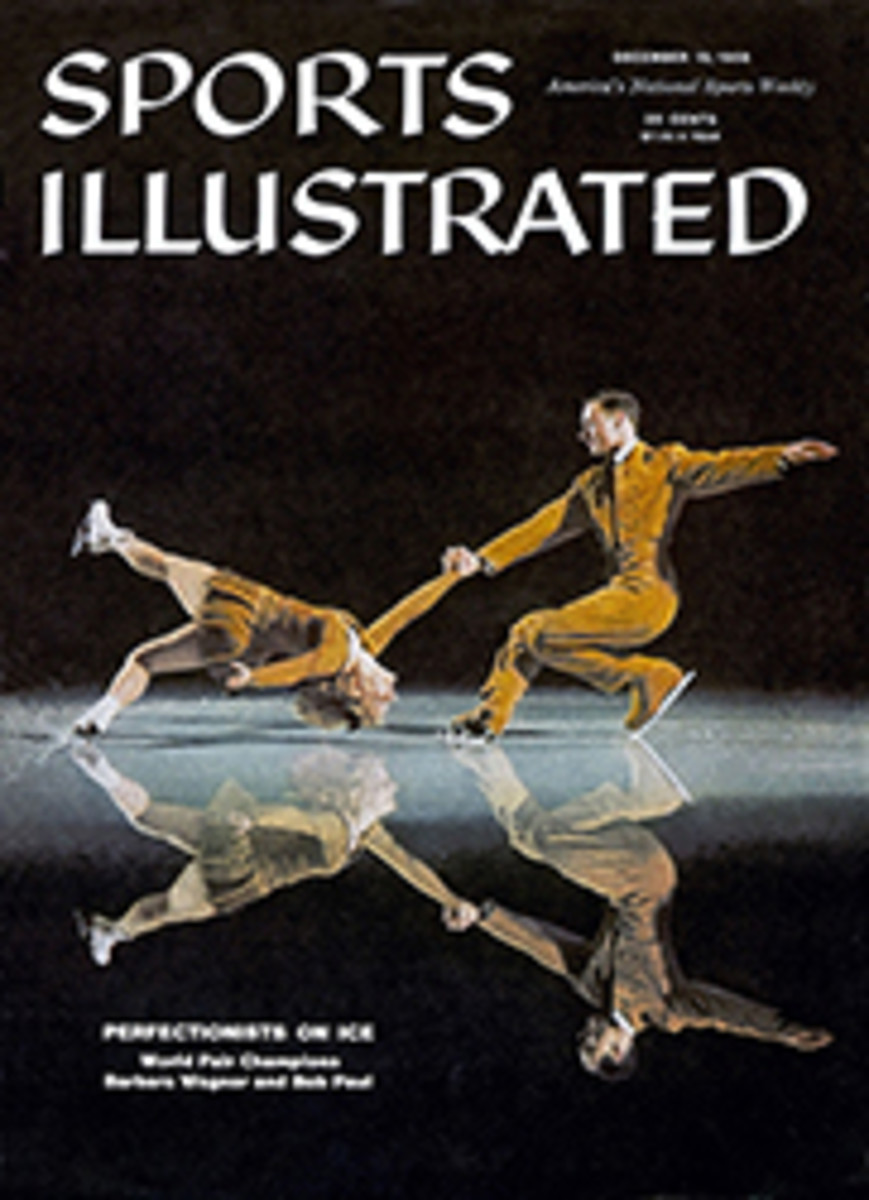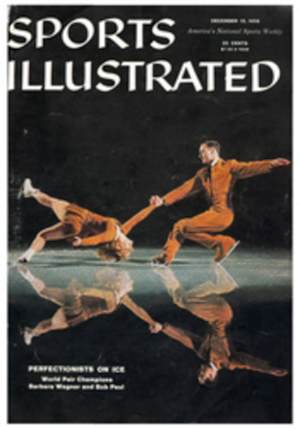
BEST ON ICE IN THE SPOTLIGHT
No two people anywhere skate together as precisely or as gracefully as the young couple on the opposite page, Bob Paul and Barbara Wagner, Canada's world pair skating champions. In a simple movement like the arabesque spiral shown here, they are virtually flawless. Their complete mastery, however, is truly proved in difficult and dangerous maneuvers like the death spiral on this week's cover. There are few pair skaters throughout the world today who will even attempt the death spiral and fewer yet who can approximate the speed with which Barbara is swung or her closeness to the ice—her hair actually brushes the surface. A fraction of an inch off in the alignment of their feet or an ounce less of the tension with which Bob holds her and Barbara would get a nasty crack on the head.
The skill involved in such perfection of timing has taken Barbara, 20, and Bob, 21, eight years of working together under the critical eye of their coach, Sheldon Galbraith. Since the essence of pair skating is the illusion of two skaters performing as a single unit, rival pros give Galbraith credit for an astonishing job in aligning two skaters of such different heights. Bob, a six-footer, is 11 inches taller than Barbara. "They've had to learn to help each other," says Galbraith, "and over the years they've found ways to compensate for the size difference. For example, Bob has to start his lifts unusually low, and if Barbara didn't give him enough spring at the right time he'd have trouble getting her up there." To keep the rhythmic flow of their skating perfect, each new maneuver is painstakingly worked out on a rink equipped with two sets of mirrors. Then Galbraith takes movies which are run and rerun until all flaws have been combed out.
Eight years ago, when Galbraith decided to put these two together, he had no intention of developing a champion pair. "Bob was a strong skater," he explains. "He was good on school figures but because he was a pretty shy kid his free skating was too inhibited. Barbara, on the other hand, was vivacious, showed a wonderful abandon in her free skating but wasn't taking a long enough stride." By pairing them off, Galbraith believed each would help the other. The success of this casual experiment is a matter of record. The pair has won every major Canadian and North American title and has won the world title twice in a row. They will defend that title this February at Colorado Springs and then set their minds on a gold medal at 1960's Squaw Valley Olympics.
To stay up at the top of the highly competitive skating world, Bob and Barbara put in five hours a day, six days a week, from November until May at the Toronto Cricket and Skating Club. Then, in July, they head for an artificial rink in the remote northern mining town of Schumacher, Ontario for grueling eight-hour-a-day summer sessions.
With such a time-consuming schedule, social activities have had to be pared to the bone and a college education sacrificed. "We had a week at Christmas time in 1956 in which to make up our minds about college," Bob recalls. "We finally decided, what the heck, we'd give skating a try, Olympics-1960-here-we-come sort of thing."
In spite of the drawbacks, skating has brought many compensations beyond the pure pleasure of winning. They have seen their own continent from coast to coast and made three trips to Europe. Last year, for example, they made an exhibition tour behind the Iron Curtain, skating in, among other cities, Prague, Warsaw and Bratislava. Bob and Barbara have one favorite routine, set to the aria "One Fine Day" from Madam Butterfly, which is full of spirals and carry lifts done at a slow tempo—a show-stopper on the carnival but impossible under the restrictive rules of competitive pair skating.
It was the Madam Butterfly number plus a fast rock 'n' roll routine they ripped off in Bratislava that gave Barbara and Bob their biggest skating thrill. At the finish the crowd lit matches throughout the darkened arena—which was a Czechoslovakian way of saying the act was great. "Then," says Barbara, "they lit their programs in a mass torchlight salute. It brought tears to our eyes."
After such a triumph, and two world titles to boot, what else can a well-balanced team like this seek as a goal? Well, one thing could be money. Of course, as amateurs neither Bob nor Barbara dares even breathe the word professional. Yet the temptation must be there. Both are attractive, and as a skating team they seem to have the showmanship that ice show promoters look for. At the moment, however, no one in the Wagner-Paul camp even hints at any such plans. "Just say that all they're interested in at the moment is winning the 1960 Olympics—please," says Bob's father. And Bob agrees: "That Olympic medal is what keeps Barbara and me going."
PHOTO
JOHN G. ZIMMERMAN
SMILING CHAMPIONS BARBARA AND BOB REST AT RINKSIDE
PHOTO
JOHN G. ZIMMERMAN
FROM THE VASTNESS of a darkened arena the searing spotlight etches on the ice the single shadow of Barbara and Bob spiraling together in perfect harmony on thin edges of steel.
THREE PHOTOS
JOHN G. ZIMMERMAN
PRACTICE SESSION begins with Coach Sheldon Galbraith demonstrating Bob's proper position (above), watching for flaws in synchronization as his world champions move into high speed and (below right) discussing a troublesome detail with Barbara.

